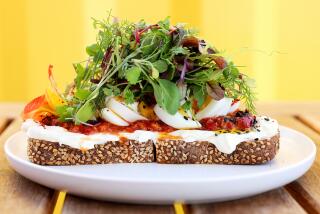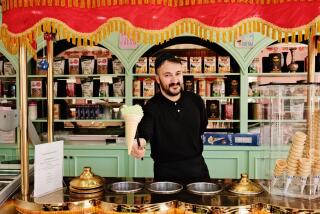Budapest Offers an Abundance of Colorful Foods
- Share via
BUDAPEST, Hungary — It is 11:30 a.m. and the lines surrounding the sausage stands at the Great Market Hall are long, but finally your turn is next. The shopkeeper holds up a piece of bread. You smile, nod your head and point to the biggest piece of sausage you can see in the steaming tray.
He wraps this garlicky delight in a rough piece of paper, crowns it with a ladle of horseradish mustard and puts it into your outstretched hand. You look for a spot at one of the uncommonly high, small counters where you stand and devour this memorable meal. You have paid 18 forints or 38 cents.
“Look at those fish; they’re immense. Why are they so crowded into those tanks?” you wonder. “How do they breathe? Why do they sell them that way instead of cleaned and filleted?”
Just then you see Joska Bacsi (Uncle Joseph) pointing to a fish in one of the tanks. A retired banker, 80-year-old Uncle Joseph rode two buses from his home in the Buda hills to buy fish for tonight’s dinner.
“The fish must be special,” he said, “and above all fresh, because we have guests from America.”
Tanks hold the firm-meated white fogas (pike-perch), catfish, Danubian carp.
You try not to wrinkle your nose, remembering carp as junk fish at home, while Uncle Joseph assures you: “You will love it!”
Cornucopia of Color
As you continue up the aisles, a cornucopia of color greets you. Stalls on either side overflow with silver-green grapes, misty blue plums and purple figs. Squash of every imaginable size and color tower high; green and red cabbages as big as cannonballs, kohlrabies, eggplant, sorrel, spinach and giant marbled Gulliver beans reach up to meet braids of garlic, bouquets of rosemary and garlands of red pepper.
At least 30 types of peppers from hot to sweet with names like paradicsompaprika (tomato pepper), csemege paprika (deluxe) and bogyiszloi (very sharp) are piled high or hang by strings.
Legs of lamb, hams of various shapes and sizes, paprika-dusted slabs of bacon are strung over long butcher counters. Heads of pigs look blankly at you as you inspect the feet of pigs and chickens and parts of animals you may never have seen before.
Exotic Cuisines
Wild boar and venison fresh from the Matra region near the Czech border--goose livers, wild duck, pheasants, woodcocks, winter and summer salamis, blood and liver sausages remind you of more exotic cuisines. Nearby, you see the more familiar pork chops, lamb and beef roasts, chickens and veal.
Smiling faces abound as you continue through the aisles. “Try some of our grapes. Ours are the sweetest,” a stall owner calls out. You stop to look, begin to pick up an especially full bunch, and the smile vanishes from the owner’s face.
“Do not touch the fruit. I will pick a bunch for you,” he admonishes. You decide to try another fruit stand.
“There they are . . . Jonathan apples,” you squeal loudly. Although a little small because it is early in the season, you must try one, now. Will it taste as good as you remember? You bite in. Yes, oh yes, it does! Crisp, juicy, tart and yet sweet--they do not taste the same in California. Is it the minerals in the soil, the freshness of the fruit or the romance of the marketplace?
For a little more than $1 you buy a bag of apples, a large bunch of grapes and a few ripe figs.
Wealthy Peasants
The peasant farmer stands among the wealthiest citizens of Hungary. Thanks to the industriousness and ingenuity of the Hungarian peasant, this country agriculturally outperforms the rest of the Soviet Bloc.
Private farms do exist in Hungary, plus the state farms. The biggest share of the land, more than 70%, is tilled by cooperatives. Members of the co-ops have a right to private slots of little more than an acre.
As you drive through Hungary you see small, squared-off parcels of land, a one-room cottage in the center, usually on the side of a hill. Here are grown the Badacsony and Tokai grapes for wine, the fruits and vegetables for market. Pigs, chickens and cows provide extra forints.
Noticing a sign above a stall, you translate: “Anna Szabo, the daughter of Istvan Karpat, whose mother was Gabriella Molnar and whose father began selling at this very spot in 1901.” The same family has held the same stall during a century of change.
History of Change
Hungary has changed, from the Austro-Hungarian Empire, to a brief Communist regime in 1919, to a kingdom governed by a regent, to a right-wing state imposed by Nazi Germany, to a socialist democracy and now a communist regime.
At one end of the Great Market Hall a table the width of the building draws your attention. Behind little nests of mushrooms hover men and women who are experts at dashing out after a rain to pick morels, chanterelles, Black Forest wild mushrooms, giant deer’s foot fungi or the classic white sampions. Next to this table you discover, on display, poisonous and friendly mushrooms. You inspect them carefully.
The Honey Ladies
Here too is a group of peasant women, dressed in regional costumes. Puff-sleeved blouses, richly embroidered, with skirts over layers of petticoats are worn proudly. Babushkas pulled far down over their crinkled eyes still show the high Mongol cheekbones. These are the honey ladies.
From the countryside they come at 4 a.m. to sell and socialize. One woman chirps: “I may be long past retirement, but as long as I can shake my plum tree and fill jars from my beehives, why shouldn’t I come from Fehervar whenever I can?”
Before leaving this gastronomic paradise you stop in front of a popular stall. A round, red-faced grinning couple stand selling pickles. Pickled cucumbers, pickled baby melons, pickled star squash and pickled green walnuts. Barrels of sauerkraut encourage you to ask for hints on how they make your favorite Hungarian dish, Transylvanian Gulyas.
What is that wonderful smell? You discover the pastry counters. No one disputes the theory that everything the Viennese know about pastry they learned from the Hungarians during the Austro-Hungarian days.
Such temptations as the dark, chocolaty Rigo Jancsi, the caramel-glazed Dobos Torta, the pink-frosted, rum-laced Punch Torta--and the ultimate indulgence of chocolate and cream, Somloi Galuska--are artistically displayed on white lace papers. Fruit tarts, Indianers, French kremes are made daily on puff pastry with generous amounts of farm-fresh whipping cream.
Three Blocks Long
Returning to the sausage stand, you look back at the Great Market Hall. Over three city blocks long, this glass-enclosed, iron latticework structure reminds you of the beautiful train stations of Europe.
Architects from all Europe, including Gustav Eiffel, competed for the honor of designing this market. When it was finally commissioned, the award went to a famous Hungarian, Samu Pecz. It was completed in 1895.
It is mid-afternoon, when Hungarians stop for a pastry and a presso-kave at an outdoor cafe. Why not join them? You order one, maybe two of those melt-in-your mouth tortas. After all, they are flourless.
Reminder: A visa is required to enter Hungary. It’s obtainable either at the port of entry or from the Hungarian Embassy in Washington, D.C.; the fee is $10. Embassy of the Hungarian People’s Republic, 3910 Shoemaker St. N.W., Washington, D.C., 20008.
For additional information about Hungary, contact Centrotourist International, 630 Fifth Ave., Suite 2455, New York 10111, or call (212) 582-7412.
More to Read
Eat your way across L.A.
Get our weekly Tasting Notes newsletter for reviews, news and more.
You may occasionally receive promotional content from the Los Angeles Times.







